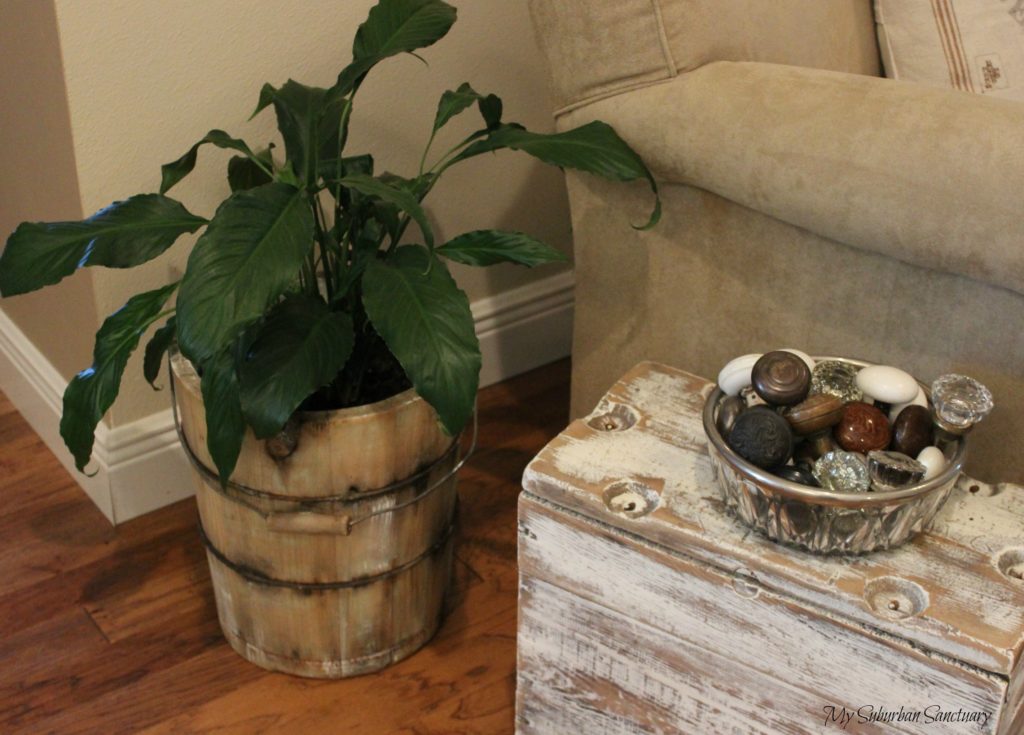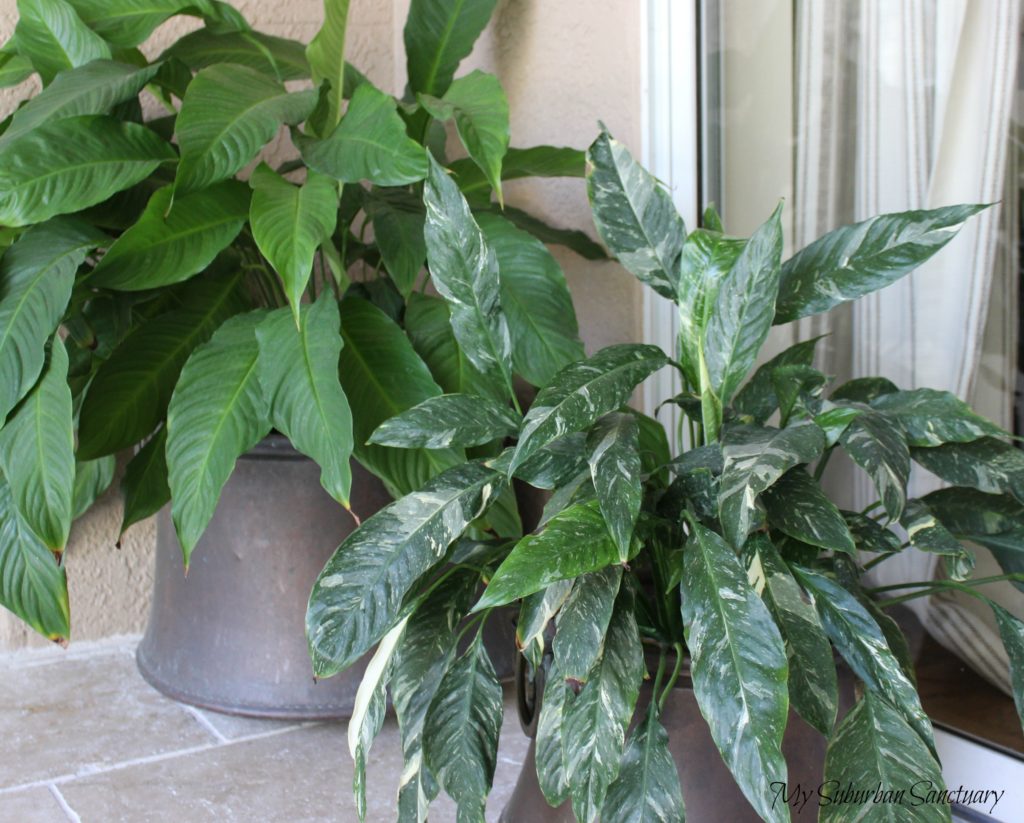

This post is all about Peace Lily, or as it’s known to the horticultural types, Spathiphyllum. (Fair warning, this is a lengthy post.) Peace Lily is a great plant for beginners and experts alike. It does require a bit more attention than either Ponytail Palm or ZZ plant, but not substantially more. In spite of its name, it isn’t a true Lily, it’s a member of the Araceae family and is native to the forests of South America. It’s on NASA’s list of the top 10 best house plants due to its ability to clean air. Peace Lily is great at breaking down and neutralizing Benzene, Carbon Monoxide and Formaldehyde, making it a great choice for bedrooms and offices. It generally stays within the two to three foot size indoors, but in ideal growing conditions and repotting when it needs it, can grow up to 6 feet, making a striking focal point in a room.
Peace Lily’s needs are relatively simple. It needs indirect light and moist soil. Too much light will result in yellow leaves, some will show brown spots and streaks. Too little light and the plant will lose vigor and eventually die. It can survive quite well in an office under florescent lights, and in dim rooms for awhile. If you want to keep one in a room without much light, move it temporarily where it can receive several hours of light a couple of days a week. If this seems like too much work remember that it can live for years with proper care, and with it’s beauty and air cleaning abilities, moving it to get light now and then is worth the effort. The blooms aren’t especially showy but when the plant is in full bloom it’s quite beautiful. White bracts arise on slim stalks above the leaves. The name, Peace Lily, was given because some people believed the bracts resembled white flags of truce. Normal bloom times are spring and fall, but it can bloom anytime during the year with the right lighting. When the flowers are spent, trim the stem at the leaf joint. Remove dead leaves as they occur to keep it looking well groomed.

One of the great things about Peace Lily apart from its appearance, is it will actually let you know when it needs water. When the leaves begin drooping it’s time to give it a drink. If you come home from a busy weekend or trip and find your Peace Lily’s leaves completely wilted and hanging over the edge of the pot, don’t throw it out. Water well and mist its leaves, it should recover. Too many of these rescues, however, will cause the plant to lose vigor and eventually it will no longer thrive. Make sure to check your plant’s soil weekly, using the “old finger test” to see if the soil is moist. If you want to know what the old finger test is, refer to Parts 1 and 2 of the Goof Proof Plant series. (See how clever I am, getting you to read those other posts??) Peace Lily is sensitive to chlorine and will develop brown leaf tips in its presence. Before watering let the water stand overnight to let the chlorine neutralize. Or use filtered spring water. Or live with brown tips like I do.
Fertilizing isn’t a must for this plant. Some growers never fertilize it, but most plant people agree that fertilizing once a year (in spring) will help your plant live a long and healthy life. Commercial liquid fertilizers may have too much salt, again causing leaf tip browning, so use a very weak fertilizer solution (mix with water), or a slow release type. I add composted cow manure to the top of my pots once a year instead of fertilizer. You can find bagged compost at any garden center or big box store. (Don’t worry, your home will not smell like a cow barn, compost doesn’t stink, feel free to add it to your plants.)

Rot is the biggest enemy of Peace Lily. Most people kill their plants with kindness by over watering. Use a pot with a built in saucer to allow the excess water to drain away. I use plastic pots inside my decorative containers so that I don’t ruin my containers, I get the look I want and don’t have to look at cheesy plastic pots. Plastic pots should be banned from view, don’t you think? Where was I? Oh yes, watering. Water when needed, on the plant’s schedule. Test the soil. Periodically check your plants for signs of rot. Leaves will appear limp, and light green. Do the smell test. Rotting plants will smell…bad. The soil will smell bad. You won’t like it. Neither will your plant. Take the plant out of its pot, if you see or smell signs of rot, remove the plant and knock the wet soil off the rootball. Trim the rotted roots off, clean and sterilize your pot with a weak solution of bleach and water, rinse well and dry. Add new soil, plant and then water. Check every few days to see if it needs more water, if so, water thoroughly and then let it dry a bit until the leaves start drooping, then water. Don’t fertilize until your plant has fully recovered.
Dust leaves on a regular basis. Dust build up blocks the plant’s ability to use light. Commercial shine products aren’t recommended because they clog the pores of the leaves, a paper towel or sponge dampened with plain water is all that’s needed. Peace Lily is mostly pest free, but it does occasionally become a victim of Peace Lily Aphids, tiny green sucking insects that leave behind a sticky slime. Treat with insecticidal soap. (Be sure to read package directions.) Mealy bugs are infrequently a problem, they are small pinkish or yellowish bugs and can be treated by wiping with cotton balls dampened with alcohol, use an alcohol soaked Q tip to get into the joints of stems and leaves.
If your plant seems to need water every few days and you can see roots at the top of the pot, it’s time to move it to a bigger pot or divide it and end up with another…free plant. (yay! I love free!) Dividing is a simple process. Remove the plant from its container and gently pull the roots apart with your hands. You’ll be able to see “clumps” of the plant. If you want to divide it, just gently pull one of the clumps, holding it by the base of the leaves, until the clump separates from the mother plant. Repot the mother plant in its old container, adding new soil. Water. Plant your new division in a pot that is suitable for its size, 2-3 inches larger in diameter than the plant is wide. Use a good quality potting mix. Tamp the soil down in the pots to get rid of air pockets and don’t let the soil pile up around the base of the leaves. Water and move to its new location. If you are going to repot your original plant to a bigger pot, use a size larger than than the current one. (example; from a 1 gallon to a 2 gallon, or a 3 gallon if no 2 gallons are available, from a 3 gallon to a 5, etc.)
Peace Lily’s leaves are toxic to dogs and cats but not generally fatal. Cats are a bit more sensitive. One bite and most pets will spit out the leaf. There may be some pawing at the mouth and/or salivating because the oxylate in the leaves burns the sensitive tissues in the mouth, if swallowed, count on cleaning up vomit. So…. If you have small children and pets, take care not to let them eat the leaves. If in doubt, always call your Doctor or Veterinarian immediately. All things considered, Peace Lily is a beautiful addition to any style home and worth the bit of extra effort. Give one a try. I’m betting you’ll love this beautiful plant as much as I do.
Recent Comments